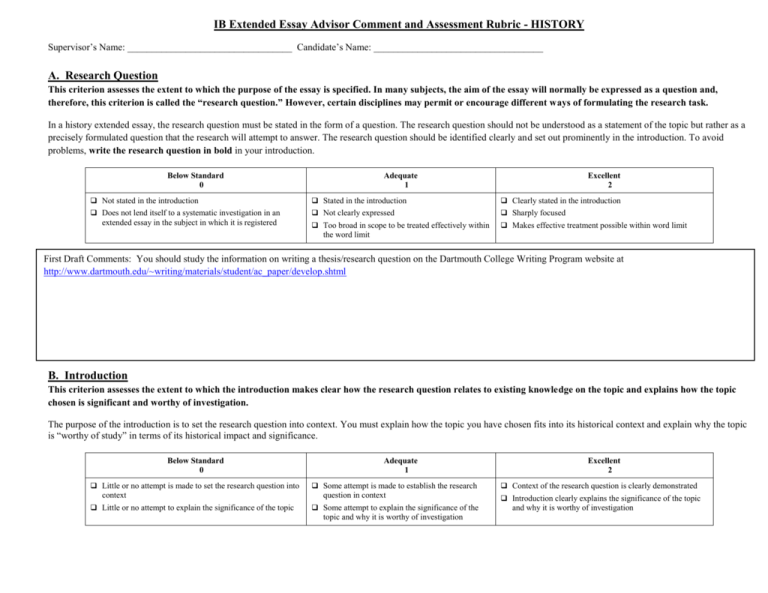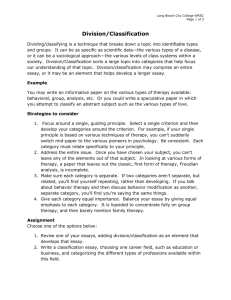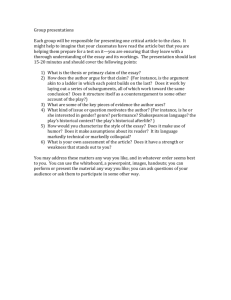History EE Rubric - Uplift Education
advertisement

IB Extended Essay Advisor Comment and Assessment Rubric - HISTORY Supervisor’s Name: __________________________________ Candidate’s Name: ___________________________________ A. Research Question This criterion assesses the extent to which the purpose of the essay is specified. In many subjects, the aim of the essay will normally be expressed as a question and, therefore, this criterion is called the “research question.” However, certain disciplines may permit or encourage different ways of formulating the research task. In a history extended essay, the research question must be stated in the form of a question. The research question should not be understood as a statement of the topic but rather as a precisely formulated question that the research will attempt to answer. The research question should be identified clearly and set out prominently in the introduction. To avoid problems, write the research question in bold in your introduction. Below Standard 0 Adequate 1 Excellent 2 Not stated in the introduction Stated in the introduction Clearly stated in the introduction Does not lend itself to a systematic investigation in an Not clearly expressed Sharply focused Too broad in scope to be treated effectively within Makes effective treatment possible within word limit extended essay in the subject in which it is registered the word limit First Draft Comments: You should study the information on writing a thesis/research question on the Dartmouth College Writing Program website at http://www.dartmouth.edu/~writing/materials/student/ac_paper/develop.shtml B. Introduction This criterion assesses the extent to which the introduction makes clear how the research question relates to existing knowledge on the topic and explains how the topic chosen is significant and worthy of investigation. The purpose of the introduction is to set the research question into context. You must explain how the topic you have chosen fits into its historical context and explain why the topic is “worthy of study” in terms of its historical impact and significance. Below Standard 0 Adequate 1 Excellent 2 Little or no attempt is made to set the research question into Some attempt is made to establish the research Context of the research question is clearly demonstrated context Little or no attempt to explain the significance of the topic question in context Some attempt to explain the significance of the topic and why it is worthy of investigation Introduction clearly explains the significance of the topic and why it is worthy of investigation First Draft Comments: You should study the information on writing a thesis/research question on the Dartmouth College Writing Program website at http://www.dartmouth.edu/~writing/materials/student/ac_paper/write.shtml C. Investigation This criterion assesses the extent to which the investigation is planned and an appropriate range of sources has been consulted, or data has been gathered, that is relevant to the research question. Students must have consulted (and cited) a sufficiently extensive and varied range of sources, preferably including both primary and secondary sources. *Where the research question does not lend itself to a systematic investigation in the subject in which the essay is registered, the maximum level that can be awarded for this criterion is 2. Below Standard 0 First Draft Comments: Little to no evidence that sources have been consulted or data gathered Little to no evidence of planning in the investigation Marginal 1 A range of inappropriate sources has been consulted or inappropriate data has been gathered There is little evidence that the investigation has been planned Adequate 2 A limited range of appropriate sources has been consulted or data has been gathered Some relevant material has been selected There is evidence of some planning in the investigation Good 3 Excellent 4 A sufficient range of An imaginative range of appropriate sources has been consulted or data has been gathered Relevant material has been selected The investigation has been satisfactorily planned appropriate sources has been consulted or data has been gathered Relevant material has been carefully chosen The investigation has been well planned D: Knowledge and Understanding of Topic “Academic context”, as used in this guide, can be defined as the current state of the field of study under investigation. However, this is to be understood in relation to what can reasonably be expected of a pre-university student. For example, to obtain a level 4, it would be sufficient to relate the investigation to the principal lines of inquiry in the relevant field; detailed, comprehensive knowledge is not required. The essay should have a solid foundation of specific relevant knowledge, whose meaning is understood by the student. This knowledge can then be analysed and, on the basis of this analysis, an argument can be formed and a conclusion to the research question reached. *Where the research question does not lend itself to a systematic investigation in the subject in which the essay is registered, the maximum level that can be awarded for this criterion is 2. Below Standard 0 Essay demonstrates no real Marginal 1 knowledge or understanding of the topic Adequate 2 Essay demonstrates some knowledge but little understanding of the topic Essay shows little awareness of an academic context for the investigation Good 3 Essay demonstrates an adequate knowledge and some understanding of the topic Essay demonstrates good Essay shows some awareness of an academic context for the investigation Where appropriate, the essay knowledge and understanding of the topic successfully outlines an academic context for the investigation Excellent 4 Essay demonstrates a very good knowledge and understanding of the topic Where appropriate, the essay clearly and precisely locates the investigation in an academic context First Draft Comments: E. Reasoned Argument This criterion assesses the extent to which the essay uses the material collected to present ideas in a logical and coherent manner, and develops a reasoned argument in relation to the research question. Students should be aware of the need to give their essays the backbone of a developing argument. Personal views should not simply be stated but need to be supported by reasoned argument based on specific details, to persuade the reader of their validity. Straightforward descriptive or narrative accounts that lack analysis do not usually advance an argument and should be avoided. Below Standard 0 *Where the research question does not lend itself to a systematic investigation in the subject in which the essay is registered, the maximum level that can be awarded for this criterion is 2. No attempt to develop a reasoned argument in relation to the research question Marginal 1 Adequate 2 Good 3 Excellent 4 Limited or superficial attempt Some attempt to present ideas Ideas are presented in a logical Ideas are presented clearly and to present ideas in a logical and coherent manner Limited or superficial attempt to develop a reasoned argument in relation to the research question in a logical and coherent manner Some attempt to develop a reasoned argument in relation to the research question, but this is only partially successful and coherent manner A reasoned argument is developed in relation to the research question, but with some weaknesses in a logical and coherent manner Essay succeeds in developing a reasoned and convincing argument in relation to the research question First Draft Comments: Information of formulating a reasoned argument can be found at http://www.dartmouth.edu/~writing/materials/student/ac_paper/logic.shtml F. Application of Analytical and Evaluative Skills Appropriate to the Subject Analysis is a very important historical skill. Students should analyse (that is, consider the meaning and importance of) the relevant factual evidence/data produced by their research, to argue a case and reach a conclusion. Sources used in the research process should be evaluated and their reliability assessed. Below Standard 0 Essay shows no application of appropriate analytical and evaluative skills Marginal 1 Essays shows little application of appropriate analytical and evaluative skills Adequate 2 Good 3 Essay shows some application Essay shows sound application of appropriate analytical and evaluative skills of appropriate analytical and evaluative skills First Draft Comments: Check with http://www.dartmouth.edu/~writing/materials/student/ac_paper/what.shtml#argument Excellent 4 Essay shows effective and sophisticated application of appropriate analytical and evaluative skills G: Use of Language Appropriate to the Subject Students writing extended essays in history need to take three factors into consideration for this criterion: the language must be clear and unambiguous, historical terminology should be used, and statements should be specific and precise, avoiding sweeping generalizations and unsupported assertions. This criterion is not meant to disadvantage students who are not writing in their first language—as long as the meaning is clear, the historical content will be rewarded. Below Standard 0 Language used is inaccurate and unclear No effective use of terminology appropriate to the subject Marginal 1 Adequate 2 Language used sometimes communicates clearly but does not do so consistently Use of terminology appropriate to the subject is only partially accurate Good 3 Language used for the most Language used communicates part communicates clearly Use of terminology appropriate to the subject is usually accurate clearly Use of terminology appropriate to the subject is accurate, although there may be occasional lapses Excellent 4 Language used communicates clearly and precisely Terminology appropriate to the subject is used accurately, with skill and understanding First Draft Comments: Style and usage help can be found at http://www.dartmouth.edu/~writing/materials/student/ac_paper/style.shtml H: Conclusion This criterion assesses the extent to which the essay incorporates a conclusion that is relevant to the research question and is consistent with the evidence presented in the essay. The most important aspect of the conclusion of a history essay is that it must reflect the evidence and argument presented in the body of the essay. It should also answer the research question asked, and if the data and analysis failed to do so, the conclusion must state this as well as any other problems encountered. Below Standard 0 Little or no attempt is made to provide a conclusion that is relevant to the research question Adequate 1 A conclusion is attempted that is relevant to the research question but may not be consistent with the evidence presented in the essay Excellent 2 An effective conclusion is clearly stated Conclusion is relevant to the research question and consistent with the evidence presented in the essay Where appropriate to the subject concerned, the conclusion includes unresolved questions First Draft Comments: I: Formal Presentation This criterion assesses the extent to which the layout, organization, appearance and formal elements of the essay consistently follow a standard format. The formal elements are: title page, table of contents, page numbers, illustrative material, quotations, documentation (including references, citations and bibliography) and appendices (if used). Biological investigations often require the support of referenced material, not only in the form of text or data, but also as diagrams or drawings. Care must be taken to supply references for illustrations taken from sources. Students must avoid the temptation to supply illustrations for their own sake. Illustrative material should only be included if it enhances the argument or supplies information that cannot be easily provided in another way. Original photographs, photocopies or downloaded images that are not labeled or put into the context of the investigation are unlikely to enhance the essay. Biological investigations often result in large quantities of raw data. Large tables of raw data are best included in an appendix. Processed data that is central to the argument of the essay should be included in the body of the essay, as close as possible to its first reference. Below Standard 0 Formal presentation is unacceptable Essay exceeds 4000 words First Draft Comments: Marginal 1 Formal presentation is poor Is within the word limit Adequate 2 Formal presentation is satisfactory Is within the word limit Good 3 Formal presentation is good Is within the word limit Excellent 4 Formal presentation is excellent Is within the word limit J: Abstract The abstract must consist of three elements: the research question (or hypothesis), the scope of the essay (that is, what was investigated and how it was investigated) and the conclusion. An abstract is not a precis of the topic. Below Standard 0 Adequate 1 Excellent 2 Does not state the research question States the research question that was investigated Clearly states the research question that was investigated Does not state how the investigation was undertaken States how the investigation was undertaken Clearly states how the investigation was undertaken Does not state the conclusions of the essay States the conclusions of the essay Clearly states the conclusions of the essay Exceeds 300 words Is within the word limit Is within the word limit First Draft Comments: K: Holistic Judgment The purpose of this criterion is to assess the qualities that distinguish an essay from the average, such as intellectual initiative, depth of understanding and insight. While these qualities will be clearly present in the best work, less successful essays may also show some evidence of them and should be rewarded under this criterion. Qualities that are rewarded under this criterion include the following. Intellectual initiative: Ways of demonstrating this in biology essays include the choice of topic and research question, and the use of novel or innovative approaches to address the research question. Insight and depth of understanding: These are most likely to be demonstrated as a consequence of detailed research and thorough reflection, and by well-informed and reasoned argument that consistently and effectively addresses the research question. Originality and creativity: These will be apparent by clear evidence of a personal approach backed up by solid research and reasoning. Below Standard 0 Marginal 1 Adequate 2 Good 3 Essay shows no evidence of Essay shows little evidence of Essay shows some evidence of Essay shows clear evidence of intellectual initiative, depth of understanding and insight intellectual initiative, depth of understanding and insight intellectual initiative, depth of understanding and insight intellectual initiative, depth of understanding and insight First Draft Comments: Excellent 4 Essay shows considerable intellectual initiative, depth of understanding and insight Submitted to turnitin.com yes no Works Cited/Works Consulted Page is free of errors yes no Disclaimer: The draft score is assigned at the school level by the candidate’s supervisor. It is a formative evaluation intended to help the student revise the essay. The finished essay is rescored by the supervisor and submitted as the student’s predicted grade on the extended essay. The actual/official extended essay score is determined by the mark received from external IBO examiners. A. Research Question B. Introduction C. Investigation D. Knowledge/Understanding of Subject E. Reasoned Argument F. Analytical and Evaluative Skills G. Use of Language H. Conclusion I. Formal Presentation J. Abstract K. Holistic Judgment Total: _____ _____ _____ _____ _____ _____ _____ _____ _____ _____ _____ /36 ESTIMATED GRADE BOUNDARIES Excellent 36-30 Good 29-25 Satisfactory 24-17 Mediocre Elementary OVERALL ASSESSMENT: A Work of an excellent standard B Work of a good standard C Work of a satisfactory standard D Work of a mediocre standard E Work of an elementary standard 16-9 8-0








